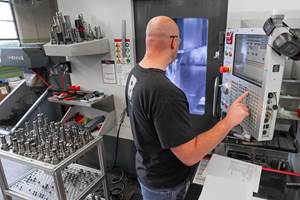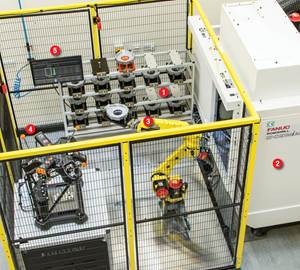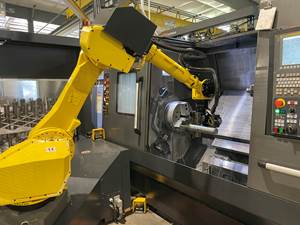Flexible Robot Arm Boosts Production
By incorporating Universal Robot’s UR5 robot arm into its production process, RSS Manufacturing & Phylrich was able to take on a new job and free 30 percent more capacity from existing machines.
Share





In order to take on a new job, RSS Manufacturing & Phylrich contemplated adding a third shift and purchasing another machine for its Costa Mesa, California factory. However, the company soon realized these actions would be unnecessary and instead purchased a robot arm from Danish manufacturer Universal Robots. The arm proved to be an inexpensive automation solution that could be easily moved between CNC machines, assembly lines and tube benders. The robot arm helped increase productivity and open machine capacity through its ability to work 24/7.
RSS Manufacturing & Phylrich employs 72 people and manufactures plumbing fixtures and fittings for faucets in its 65,000-square-foot factory. The company specializes in short-run production with turnaround time as quick as 24 hours. When a new job required the company to make 700 valves each month on a CNC machine that normally produced 400 valves per month running two shifts, RSS turned to the UR5 robot arm from distributor Sparkem Technology and incorporated it into the shop for 24/7 production. “In a flexible environment like this, you need a flexible robot: one that can work without safety cages, is portable, and can be reprogrammed quickly,” says CEO Geoff Escalette.
By increasing the run rate, the company completed the new order within 11 days of purchasing the robot arm. It also opened 30 percent more capacity on existing machinery, he says. The robot’s return on investment (ROI) in this particular application is a couple months, Mr. Escalette says, but by moving it to various machines, the ROI is about 6 months.
Before integrating the robot into production, Shane Strange, RSS automation and integration specialist, and his team assessed its safety by experimenting with various accelerations and joint speeds testing how much force it could take before failing.
“The robot is surprisingly sensitive to outside force and will stop immediately when colliding with a person,” he says. Its high level of sensitivity enables it to run without safety cages. Instead, the company uses a light curtain as an extra safety measure when the robot works on an assembly line with workers stationed next to it. Mr. Strange explains that the light curtain is a simple, portable solution that plugs right into the I/O of the robot. If a person crosses the light barrier, the robot automatically stops. “We can just wheel the curtain to wherever the robot goes. It’s not a big deal at all,” he says. Moving the robot from one area to the next and preparing it for a new assignment takes about 30 minutes, including all safety measures.
Safety isn’t the only area in which the robot eliminated external costs. “We’ve had no external costs to speak of because the robot operates without safety guarding. In terms of end-effectors, you don’t need fancy fixtures, you just need to think outside the box,” Mr. Escalette says. In fact, RSS produced the aluminum fingers that the robot uses to lift milled parts out of the CNC mill. The company purchased the robot’s sensor motor coordination (SMC) end-effectors on Ebay for $79 each.
The robot arm proved easy to integrate. Mr. Strange says setting up the UR5 took 45 minutes. “That’s how much time we spent to unpack, mount and program it to do some simple pick-and-place moves,” he says. To create the complete setup, which includes all the tooling, Mr. Strange says he worked a total of 8 hours. “I’ve worked with other robotic models in the past, and it’s one thing to say it’s easy to program, but it’s another to integrate it into a real application,” he says. “But the UR5 is really easy to integrate. If you can write a to-do list, you can program this robot.”
From a programming perspective, Mr. Strange says the tablet interface is one of the most significant benefits of the UR5 robot. It enables him to stay with the robot and troubleshoot along the way rather than running a simulation, and later return to the shop floor to boot up the robot and watch it perform in real-time.
To realize maximum production benefits when the UR5 was used with a mandrel tube bender, adjustments needed to be made. For instance, the RSS team found the robot’s fast operation to be problematic when feeding tubes into the machine. “We had not expected the robot to be able to operate so fast,” Mr. Escalette says. “It pushed the limits of the mandrel bender so much that hydraulics in the bender overheated and started to malfunction.” However, before the equipment malfunctioned, it was able to produce 1,500 pieces in 4 hours. With manual labor, it would’ve taken two employees 3 days to achieve that level of productivity. The company has since optimized the bender to keep up with the robot, Mr. Escalette says.
So far, the UR5 has worked with a Hurco CNC machine and a mandrel tube bender. The next job the UR5 will perform at RSS will be buffing and polishing. “What initially got us excited about the UR robots is their ability to exert a certain amount of pressure through the advanced force control feature. It’s very hard to find employees who can manually polish brass fittings, and now we use the robot for this task,” Mr. Escalette says.
He admits that his employees did not greet the UR5 with overwhelming enthusiasm when it first arrived. “They thought they were looking at their replacement. But now, we can educate and promote our employees, from machine operators to robot programmers and quality control inspectors,” he says, explaining that the initial employee fear of the robot has since vanished. “When they realized how easy it was to use and what they’ll eventually be doing with it, they all embraced it. Now, they are excited to become the first guy who gets to start programming the robot.”
Related Content
Increasing Productivity with Digitalization and AI
Job shops are implementing automation and digitalization into workflows to eliminate set up time and increase repeatability in production.
Read MoreMedical Shop Performs Lights-Out Production in Five-Axes
Moving to five-axis machining enabled this shop to dramatically reduce setup time and increase lights-out capacity, but success relied on the right combination of workholding and automation.
Read More5 Stages of a Closed-Loop CNC Machining Cell
Controlling variability in a closed-loop manufacturing process requires inspection data collected before, during and immediately after machining — and a means to act on that data in real time. Here’s one system that accomplishes this.
Read MoreSame Headcount, Double the Sales: Successful Job Shop Automation
Doubling sales requires more than just robots. Pro Products’ staff works in tandem with robots, performing inspection and other value-added activities.
Read MoreRead Next
Machine Shop MBA
Making Chips and 91ÊÓƵÍøÕ¾ÎÛ are teaming up for a new podcast series called Machine Shop MBA—designed to help manufacturers measure their success against the industry’s best. Through the lens of the Top Shops benchmarking program, the series explores the KPIs that set high-performing shops apart, from machine utilization and first-pass yield to employee engagement and revenue per employee.
Read MoreAMRs Are Moving Into Manufacturing: Considerations for Implementation
AMRs can provide a flexible, easy-to-use automation platform so long as manufacturers choose a suitable task and prepare their facilities.
Read MoreLast Chance! 2025 Top Shops Benchmarking Survey Still Open Through April 30
Don’t miss out! 91ÊÓƵÍøÕ¾ÎÛ's Top Shops Benchmarking Survey is still open — but not for long. This is your last chance to a receive free, customized benchmarking report that includes actionable feedback across several shopfloor and business metrics.
Read More





















